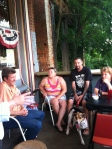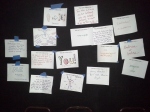HOW TO USE THIS BLOG
In 2013, PearlDamour and Haymaker, two performance making ensembles, received a grant from the Network of Ensemble Theaters (NET) to support a series of exchanges around audience development and aesthetics. This blog gives a window into three summits the companies designed and attended over the course of the year – one in Raleigh-Durham, one in New Orleans, one in cyberspace via Skype.
Since the exchanges were happening over the course of a year, with the companies and their priorities growing and changing throughout, we find it most interesting to explore this blog in the order the exchanges happened: first in Durham, then in New Orleans, and finally, in Cyberspace. The Durham exchange is arranged by day, the New Orleans and Cyberspace exchange is arranged by topic/particular musing.
While the topic of “who is our audience” travels through the entries, this blog also presents a portrait of two ensembles – one younger, one older – at specific threshold moments in their creative lives. Haymaker, a 3 year old ensemble self-producing original work in Durham, was dealing with creative and administrative burnout issues stemming from producing original work while holding down day jobs; PearlDamour, a 16 year old ensemble, was in the middle of managing one of their largest projects to date with minimal administrative support. Over the course of the year, as we worked through questions we had around audience development, we found ourselves giving each other much needed support around company sustainability: exchanging on how to support individual growth within company growth and reflecting on the value of scheduling in bursts of productivity and periods of rest and reflection.
Below, you can find selections from our original grant proposal. As you explore the blog, you will see the ways in which the conversation expanded from our original ideas. While the official grant period is over, PearlDamour and Haymaker will continue to collaborate as PearlDamour moves towards the premiere of MILTON in Milton, NC – check back here in June and September of 2014 for updates.
Thanks and Enjoy,
PearlDamour and Haymaker Theater
***
PEARLDAMOUR/HAYMAKER: Excerpt from Original Exchange Grant
PearlDamour and Haymaker are two companies focused on creating meaningful connections with their audiences using experimental performance practices in non-traditional spaces. Currently, each company has a piece in development – Haymaker’s What’s That Cost: The Federal Budget and You and PearlDamour’s Milton – aimed at investigating the practice of creating and performing experimental work in non-performance spaces for non-theatre ‘going’ audiences. Together, with the support of NET’s Exchange grant, the companies propose spending a year creating new work, exploring engagement strategies, and reporting on the successes and failures of a shared dilemma: How do we address the disconnect between the art we make and the audiences we want to see it? Between June 2013 and March 2014, Haymaker and PearlDamour will convene three times to discuss and develop ways to create and engage, to introduce each other to new artists and audiences, and to assess each other’s work and practices.
PearlDamour and Haymaker are both experimental in our performance practices, favoring non-traditional performance spaces and intimate audience relationships in order to trouble the standard actor/spectator relationship and achieve a meaningful connection with our audiences. We are comfortable in these experiments with form and content, in part because our audiences are, in general, educated in the ways of experimental theater. But comfort is not what we want to be feeling right now. We are ready to examine our practice on unfamiliar ground, opening ourselves up to the challenge of making work for new audiences who may NOT have a shared history in experimental performance.
Each company is now engaged in projects that offer a terrific opportunity for us to do just that: PearlDamour’s Milton has the ensemble traveling to 5 different cities named Milton to interview residents in order to build a piece that connects the 5 Miltons and is performed in each one; Haymaker designed What’s that Cost specifically to be performed in a range of non-traditional performance spaces and for non-traditional theatre audiences. PearlDamour is eager to develop Milton with Haymaker as its host and “scout team” in Milton, NC, while Haymaker is eager to continue the evolution of What’s That Cost with help from PearlDamour and the new audience in New Orleans, LA. Our NET exchange will be framed by these projects.
The exchange will be shaped by three summits. The first summit will focus on internal dialogue and skill sharing between PearlDamour and Haymaker. We will discuss performance making and audience development techniques used by each company in past productions and review primary sources to find new techniques (using such texts as Shannon Jackson’s Social Work and Jo Carson’s Spider Stories), with the goal of building strategies for the year to come.
Having identified our goals and strategies in the first summit, the second and third summits will focus on creation, exploration, and engagement. Haymaker and PearlDamour will work jointly on their works in progress. PearlDamour will observe rehearsals and performances, and help Haymaker to further develop What’s That Cost, and will organize at least one showing of their piece at a non-traditional venue for a specific audience. Haymaker will help PearlDamour by going on an initial “scouting trip” to nearby Milton, NC to get the feel of the town and identify local community gathering places not easily identified in a web search. They will also accompany PearlDamour to one of their later trips to Milton, NC to help, observe, and assess the work practiced there.
Both groups will depend on each other to help design and then assess audience engagement before, during, and after the presentations of their works. Haymaker will come out of this exchange with a performance of their work of their work in New Orleans in an unconventional setting, and an assessment of the engagement process before, during and after the performance. PearlDamour will come out of this exchange with their research done in Milton, NC, and, if the schedule aligns, a work-in-progress showing of part of their show MILTON in the Process Series at UNC, assisted by Haymaker (especially in the area of audience development and feedback).
Additionally, the summit will allow the artists to network in each other’s community and discuss audience engagement with artistic producers – sowing the seeds of ensemble collaboration within the Southeast, one of the fastest growing regions in the country. Haymaker will introduce PearlDamour to development opportunities in the Durham area, PearlDamour will introduce Haymaker to local producers at the New Orleans Fringe, the New Noise works-in-progress series, and the many ensembles (young and mature) that are working in New Orleans now.















